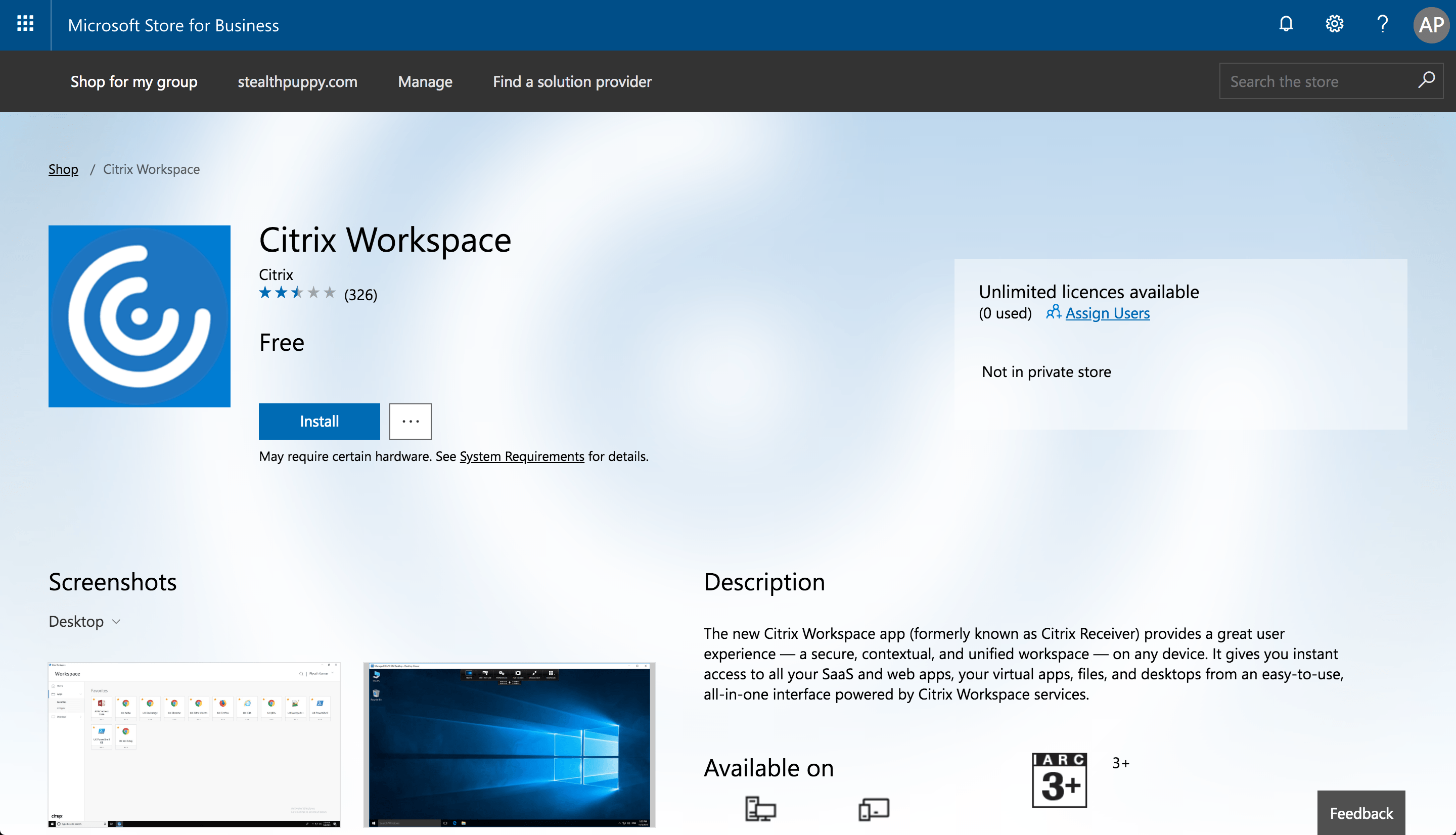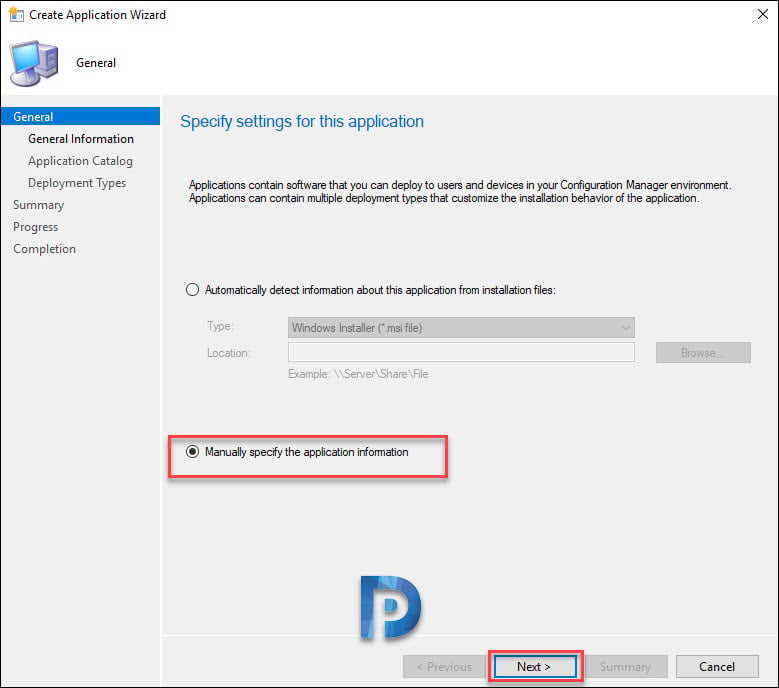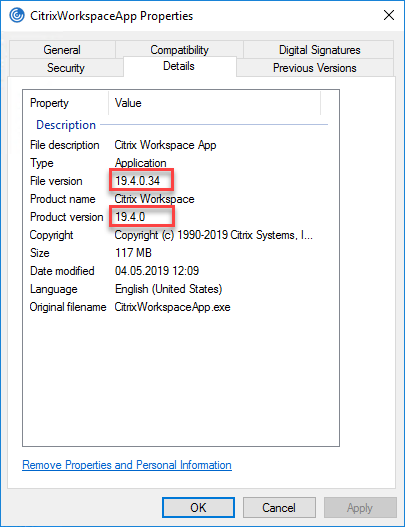Applicable Products
Configure and install Citrix Workspace app using command-line parameters; Citrix Workspace app installation file (CitrixWorkspaceApp.exe) The latest version of Citrix Workspace app can be downloaded here. The download contains one file: CitrixWorkspaceApp.exe. This file contains a number of MSI files; one MSI installer per component. Citrix Workspace app is the new universal app for all workspace services, that will encompass all Citrix clients and app capabilities over time. This article describes how to suppress the Add Account window in Citrix Receiver for Windows. Note: This article is applicable for Receiver for Windows 4.4.1000 and later. For the uninstall I use C: programdata citrix citrixreceiver trolleyexpress.exe /uninstall /silent /cleanup I use this because trolleyexpress is already on the machine after install and the cleanup command will help to remove all of the components, directories and registry entries created by the installer. titusr 6 years ago. HKEYCURRENTUSERSoftwareCitrixSplashscreen SplashscreenShown=1. This value is a string or REGSZ value. I have tested this procedure on Windows 10 v1809, Windows Server 2016 and Windows Server 2019 with Citrix Workspace App 1812. Try it out and silence that Citrix Workspace App!
- Citrix Workspace App
- Receiver for Windows
Objective
This article is intended for Citrix administrators and technical teams only.
Non-admin users must contact their company’s Help Desk/IT support team and can refer to CTX297149 for more information.
Citrix Workspace app is the new universal app for all workspace services, that will encompass all Citrix clients and app capabilities over time.
This article describes how to manually extract, install, and remove individual .msi files from CitrixReceiver.exe OR ReceiverEnterprise.exe.
You can download Citrix Receiver from here.
Instructions
Citrix does not recommend extracting the Receiver (Enterprise) .msi files instead of running the installer packages. However, there might be times when you have to extract the .msi files from CitrixReceiver.exe or CitrixReceiverEnterprise.exe manually, rather than running the installer package (for example, company policy prohibits the usage of .exe files). If you use the extracted .msi files for your installation, using the .exe installer package to upgrade or uninstall and reinstall might not work properly.
For Citrix-recommended Receiver (Enterprise) installation methods, refer to Citrix eDocs - Configure and install Receiver for Windows using command-line parameters.
Extract the .msi files
Run the following at command prompt:
For 4.x use: CitrixReceiver.exe /extract [Destination_name, e.g. C:test ]
For 3.x use: CitrixReceiverEnterprise.exe /extract [Destination_name, e.g. C:test]
where Destination _name is a complete pathname to the directory into which the .msi files are extracted. The directory must exist already and /extract adds a subfolder called extract to that directory.
For example, if you create a C:test directory and run /extract, the extracted .msi files are put in C:testextract.
Note: If User Access Control (UAC) is enabled, Citrix advises that you install the .msi files in elevated mode. The .msi files are supported per-machine and require administrator privileges to deploy them.
Install the .msi files for Receiver
Use the following command line parameter:
Note: Double click installation for Receiver using individual .msi is not recommended for 4.4.x and 4.5Install the Components:
When installing the Receiver.exe components, run the .msi files in the following order:
- RIInstaller.msi
- ICAWebWrapper.msi
- GenericUSB.msi
- DesktopViewer.msi
- CitrixHDXMediaStreamForFlash-ClientInstall.msi
- Vd3dClient.msi
- AuthManager.msi
- SSONWrapper.msi
- SelfServicePlugin.msi
- WebHelper.msi
During the execution of each of these msi packages, the following command line parameters need to specified:
REBOOT=ReallySuppress MSIDISABLERMRESTART=0 MSIRESTARTMANAGERCONTROL=0 NEED_RECEIVER=n TROLLEYINSTALL=1 ALLUSERS=1
The command to execute a msi package is as follows:
msiexec /i <path to the .msi package> REBOOT=ReallySuppress MSIDISABLERMRESTART=0 MSIRESTARTMANAGERCONTROL=0 NEED_RECEIVER=n TROLLEYINSTALL=1 ALLUSERS=1
For a non-admin user installation, the parameters are as follows:
REBOOT=ReallySuppress MSIDISABLERMRESTART=0 MSIRESTARTMANAGERCONTROL=0 NEED_RECEIVER=n TROLLEYINSTALL=1 ALLUSERS='
Note: GenericUSB and SSON are not supported for non-admin users, so no need to install GenericUSB.msi and SSONWrapper.msi for non-admin user installation.
Remove the Components:
When removing the components, remove them in the following order:

- SelfServicePlugin.msi
- SSONWrapper.msi
- AuthManager.msi
- Vd3dClient.msi
- CitrixHDXMediaStreamForFlash-ClientInstall.msi
- DesktopViewer.msi
- GenericUSB.msi
- ICAWebWrapper.msi
- RIInstaller.msi
- WebHelper.msi
Each .msi file has an Add/Remove (Control Panel on Windows XP or Windows Server 2003) or Programs and Features (Control Panel on Windows Vista, Windows 7, and Windows Server 2008) entry in the following format:
| Name of package | Name displayed in Add/Remove or Programs and Features |
| RIInstaller.msi | Citrix Receiver Inside |
| ICAWebWrapper.msi | Online Plug-in |
| PNAWrapper.msi | Citrix Receiver (PNA) |
| SSONWrapper.msi | Citrix Receiver (SSON) |
| CitrixHDXMediaStreamForFlash-ClientInstall.msi | Citrix Receiver (HDX Flash Redirection) |
| DesktopViewer.msi | Citrix Receiver (DV) |
| GenericUSB.msi | Citrix Receiver (USB) |
| Vd3d.msi | Citrix Receiver (Aero) |
| AuthManager.msi | Citrix Authentication Manager |
| CitrixReceiverUpdater-User.msi | Citrix Receiver Updater |
| SelfServicePlugin.msi | Citrix Single Sign-On Plug-in |
Note: CitrixReceiverUpdater-user.msi is not included in Citrix Receiver from version 4.3 onwards
Additional Resources
Note: A tool has been developed that automatically removes previous installations of the Citrix Receiver
Receiver Clean-Up Utility
Citrix Documentation - Citrix Receiver for Windows Enterprise 3.4 and 3
To configure Single Sign-on on a new setup:
1. Enable User name and password and Domain pass-through on StoreFront or the Web Interface
Depending on the XenApp/XenDesktop deployment, Single Sign-on authentication can be configured on StoreFront or the Web Interface using the Management Console.
StoreFront server: Launch StoreFront Studio, go to Store > Manage Authentication methods > enable Domain pass-through.
Note: Single Sign-on is not supported if Citrix Receiver for Windows is connected to XenApp/XenDesktop using NetScaler Gateway.
| Scenario | Steps | Description |
|---|---|---|
| Configured on StoreFront or the Web Interface with Management Console | StoreFront server: Launch StoreFront Studio, go to Store > Manage Authentication methods > enable Domain pass-through. | When Citrix Receiver for Windows is not configured with Single Sign-on, it automatically switches the authentication method from Domain pass-through to Username and Password, if available. |
| Receiver for Web IS Required | Launch Stores > Receiver for Websites > Manage Authentication methods > enable Domain pass-through. | When Citrix Receiver for Web is not configured to allow Domain pass-through, it automatically switches the authentication method to Username and Password, if available. If you are launching published applications using web browsers for Storeweb, enable the Single Sign-on feature as described in the sectionGroup Policy Settings. |
| StoreFront IS NOT configured | If Web Interface is configured on a XenApp server, open XenApp Services Sites > Authentication Methods > enable Pass-through. | When Citrix Receiver for Windows is not configured with Single Sign-on, it automatically switches the authentication method from Pass-through to Explicit, if available. |
2. Configure XML trust services on the Delivery Controller
On XenDesktop 7 or later or XenApp 7.5 or later, run the following PowerShell command as an administrator on the Delivery Controller:
asnp Citrix*
Set-BrokerSite -TrustRequestsSentToTheXmlServicePort $True
Refer to the Knowledge Center article: Error: 'An error occurred while making the requested connection'.
Note: On XenApp 6.5, XML Service Port and Trust is enabled using the Graphical User Interface. For more information, see Configuring the Citrix XML Service Port and Trust.
3. Modify Web Browsers settings and Install Citrix Receiver for Windows with Single Sign-on
3.1 Modify the web browsers settings
3.1.1 Configuring IE, Chrome, Edge browsers and Citrix Workspace for Windows for Single Sign-on
Modify the Internet Explorer settings to add StoreFront URL or Web Interface URL to the list of Security Zones in Internet Options. There are two methods to modify Security Zones:
NOTE: At any time, use only one of the following methods.
| Option 1 |
|---|
|
| Option 2 |
|---|
Note: Automatic logon with current user name and password can be configured using Group Policy. For more details, see Managing Browser Settings with Group Policy Tools. |
3.1.2 Configuring Firefox for Single Sign-on
- Open Firefox
- Type about:config in the address bar
- A security warning page will appear. To continue, click “I accept the risk!”

- List of configurations will be available. In the search bar type “network.automatic-ntlm-auth.trusted-uris” and add the store URL to that configuration
3.2 Install Citrix Receiver for Windows

- Download Citrix Receiver for Windows (CitrixReceiver.exe) from Citrix Downloads.
- Log onto the client device with administrator privilege.
- You can install Citrix Receiver for Windows in two ways:
Using the Graphical User Interface Using the Command Line Interface - Double-click CitrixReceiver.exe.
- In the Citrix Receiver Installation wizard, select Enable Single Sign-on.
- Click Next.
- After the installation is complete, log off from the client device and log on again.
- Open a command prompt as an administrator and change to the directory to where CitrixReceiver.exe is located.
- Run the following command to install Citrix Receiver for Windows with the Single Sign-on feature enabled:
CitrixReceiver.exe /includeSSON /silent
- After the installation is complete, log off from the client machine and log on again.
- Launch the Task Manager to verify that the ssonsvr.exe process is running.
Users should now be able to log on to an existing Store (or configure a new Store) using Citrix Receiver for Windows without providing credentials.
Group policy settings
Configuration described in this section is required in two cases:
• When access to StoreWeb using web browsers is required.
• Citrix Receiver for Windows version 4.3 or earlier is used.
For newer versions of Receiver (4.4 onwards) that do not require SSON via web browsers, the configuration is optional
Using Citrix Receiver for Windows Group Policy template files
• Add Citrix Receiver for Windows template files to the Local Group Policy Editor. For more information, see Configure Receiver with the Group Policy Object template . Be sure to use the ADM template of the same version as the Receiver on the Client.Follow the below steps to configure the policy
1. Open Local Group Policy Editor. Navigate to Citrix Receiver > User authentication.2. Open the Local user name password policy.

3. Select Enable pass-through authentication.
4. Click Apply and OK.
Note: If the existing version of Citrix Receiver for Windows does not have the Single Sign-on component installed, upgrading to the latest version with the /includeSSON switch is not supported.
After the installation is complete, log off from the client device and log on again.
Single Sign-on Diagnostics
In Citrix Receiver for Windows Version 4.5, you can use Configuration Checker to diagnose the Single Sign-on configuration.
Right-click the Citrix Receiver icon in the notification area and select Advanced Preferences > Configuration Checker.
The Configuration Checker window appears.Select SSONChecker and click Run.
The test runs on all the SSON checkpoints.
After the test is complete, the results are displayed for each test.
The test describes if all the configuration requirements for Single Sign-on are met.
For more information, see Using Configuration Checker to validate Single Sign-on configuration
Verify the list of Network Providers
If users face any issues with Single Sign-on, Citrix recommends that you verify the list of network providers list on the client machin e as described below:
Citrix Workspace Switches
Click Start.
Enter View network connections. The Network Connection window appears.
Press ALT to display the menu. Click Advanced > Advanced Settings
Advanced Settings window appears.Click the Provider Order tab.
Move “Citrix Single Sign On” to the top of the list to change the order of network providers.
Citrix Workspace Installation Switch
Additional Resources
